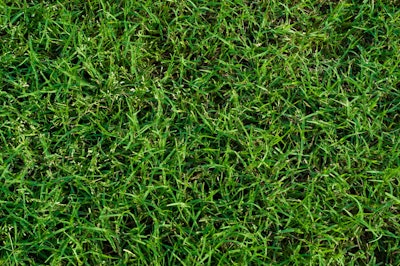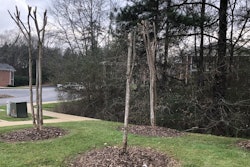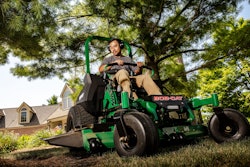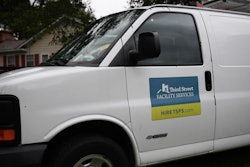
Bermudagrass will establish more quickly by seed than most warm-season options, and once it is established, it will have a faster growth rate than other warm-season grasses. Bermudagrass is also highly valued for both its heat and drought tolerance.
This grass type will spread with both above-ground stems (stolons) and below-ground stems (rhizomes), and even though its aggressive growth rate can sometimes make it hard to contain, it can withstand heavy use while being able to recuperate quickly.
Care and maintenance
According to Daniel Coleman, SiteOne assistant category manager of seed (turf and natives) and wildflowers, bermudagrass typically performs best in full, direct sun areas that are well drained.
“Generally, (bermudagrass does best) from the Atlantic across southern states and into California,” says Coleman. “Bermudagrass particularly stands up very well to drought conditions in comparison to other warm-season grasses; additionally, it has superior heat, salt, and humidity tolerance.”
Traces of bermudagrass in the South date back to the 1800s, and since it is a perennial warm-season type, it will return each year and thrive during late spring and throughout the hot summer months.
For landscapers operating in areas that receive an ample amount of cold weather and shade, bermudagrass might not be the best option, as the cold tolerance for this grass type is very low.
That being said, Coleman adds that newer varieties such as LESCO Dune and Pyramid 2 bermudagrass do have enhanced tolerance, making them more suitable for better performance in the transition zone.
“Dune bermudagrass is best known for its increased tolerance to cold temperatures showing low winter kill,” says Coleman. “Additionally, it was selected for low cut utilization and resistance to dollar spot. Pyramid 2 is very traffic tolerant for high-use areas and has shown great resistance to spring dead spot.”
The cut height for bermudagrass will vary depending on the level of maintenance it receives, but ideally, ¾-inch to 1 ½-inch is needed to optimize root development and maximize drought tolerance.
The majority of bermudagrass roots will remain within 6 inches of the surface, but sometimes they can reach 6 feet deep or more. Having a root system this extensive helps provide more resiliency against a plethora of environmental stresses.
“Because bermudagrass is often used in high-maintenance programs, the fertility requirements are higher to achieve desired turf results,” says Coleman. “Bermudagrass persists in drought conditions, but watering requirements will fluctuate based upon localized evapotranspiration rates. Typically, watering deep and infrequently will promote healthy root development.”
During the peak growing season, bermudagrass could require monthly fertilization, and it’s possible that twice-weekly mowing might also become necessary during this period to ensure it keeps its recommended height.
A soil pH ranging between 5.8 and 7.0 is ideal for bermudagrass, but it can also tolerate soil conditions that are more alkaline. If your customer’s soil does lean more toward alkaline and they desire this grass type, begin regular applications of lime to help the soil reach its optimal available nutrient levels.
What to watch for and avoid
When working with bermudagrass, one of the top misconceptions Coleman says they run into is that all bermudagrass products are seeded at the same rate. Since bermudagrass can come in hulled, unhulled, and coated forms, Coleman says this is certainly not the case.
To find the proper seeding rate, you first need to identify what form the seed is in, and it’s important to double-check your products before you ever set your planting rate.
This grass type is susceptible to diseases such as dollar spot, brown patch, leaf spot, and spring dead spot, which Coleman says is the most prevalent turf pathogen known to cause damage to bermudagrass upon the break from dormancy.
Coleman notes that some varieties of bermudagrass will exhibit additional resistance to these diseases.
Depending on your location, pest, and weed pressure will vary, but there are a few things to keep a watch for, such as: armyworms, sod webworms, bermudagrass scale, rhodesgrass mealybug, and ground pearl.










